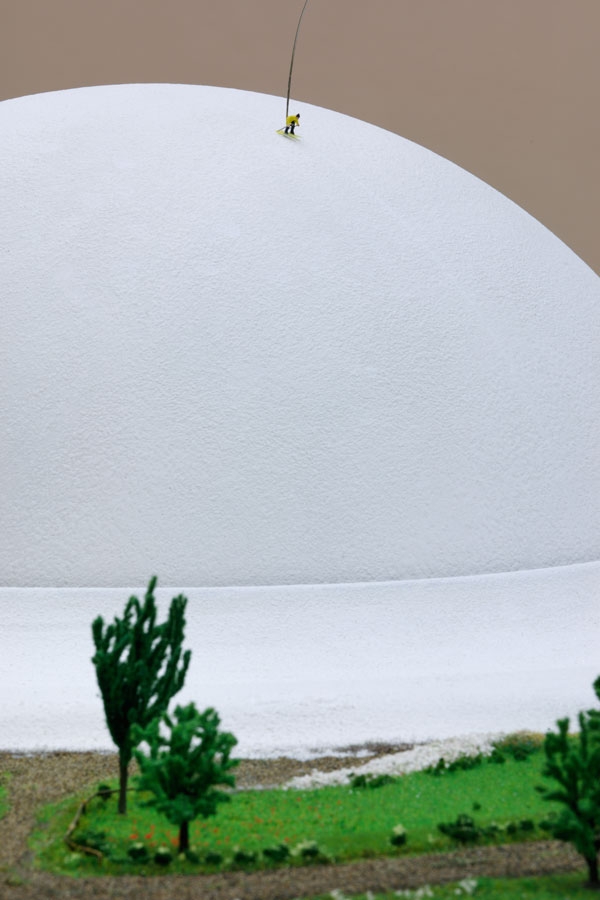27 January – 10 April 2016, Galerie Rudolfinum, Prague
In the second half of Jirí Černický’s exhibition – which is vast in terms of scale and the scope of its ambition – you encounter a tabletop landscape, one of several on show here, crafted with all the skill of a fetishistic model-railway enthusiast. Titled Endless Ski Slope (2016), it features a solitary skier endlessly schussing down a snow-covered declivity: a strange utopian dream of unlimited progress and infinite leisure. And perhaps a little futility too, because the skier doesn’t really move at all; but is rather suspended, by an almost invisible plastic wire, on top of a giant revolving snowball (the size of a large meteorite) that appears to have crashlanded, throwing out a halo of snow around it, into a verdant, sparsely wooded field. One quarter of the tableaux has been sliced away, revealing the cakelike strata of the earth beneath the table/ground. And confirming, in case you had missed it, that the snowball (operating now like some science-fictional planetary core) rotates, while the skier is static, constantly skiing in his own tracks.
Revolutions of some sort are everywhere in this exhibition. Plough (2016), for example, is a 1980 sculpture of Lenin – on loan from the city of Kyjov – installed with a 90-degree rotation. Its base, accordingly, is on the wall, and its characteristic raised left arm now points at the ground, allowing the artist to propose that that arm might be rescued from a realm of ideological redundancy and delivered to one of practical usefulness by being used to till soil. To ram that point home, he has retrofitted the hand with a plough.
Absurdity, the aesthetics of B-movies, pragmatic solutions to idiosyncratic problems, the lure of supposedly educational models, as well as something of a taste for that grey area between dedicated amateur and rigorously scientific professional – such things characterise much of the work on show here. When you first enter, an animation (based on an earlier drawing) features a giant rotating crane, covered in creepers to both baroque and dilapidating effect, from the arm of which a waterfall cascades as if to complete some sort of grotesque self-sufficient ecosystem (Kinetic Waterfall, 2016).
Wild Dreams, in turn, comprises 50 drawings (which recall Leonardo da Vinci’s plans of his inventions – further articulated in Černický’s model for a flying bicycle) worked up into the same number of sculptures and installations. It’s mindboggling in both its diversity and complexity: from cherry seeds carved with motifs from Soviet gulags (Vast Miniatures, 2013), to a bust of Stalin revolving in a microwave and triggering a series of lightninglike sparks, via a model of a social-housing block in which one apartment owner has stuck a yacht to the facade, using it as a balcony (Balcony, 2016). Of course, all of this is entertaining too, in the spirit of carnival (in the sense of Mikhail Bakhtin’s notion of ‘a temporary liberation from the prevailing truth and from the established order’) or funfair. Some works invite you to climb onto them (Memorial to the Victims of Religious Repression, 2016, a bicycle raised up between two statues of the Madonna, such that when you pedal the bicycle, its wheels create spinning halos behind their heads). Others demand that you look over, underneath and around the material in front of you – both physically and mentally.
But more than anything else, Černický’s work speaks of an optimism that, like the skier in Endless Ski Slope, doesn’t have anywhere to go. Nobody Readable (2008–16), one of the artist’s best-known works, is presented here in the form of a video of the artist, completely covered in a skin-tight bodysuit filled with advertising and marketing slogans, beneath the lights and billboards of Times Square. He both fits in and is gone, in a manner reminiscent of Harry Tuttle’s end, covered in abandoned newspapers, in the film Brazil (1985). Behind the clowning, then, is a certain melancholy, because perhaps art is the only space left in which to dream your own dreams.
This article was first published in the May 2016 issue of ArtReview.
